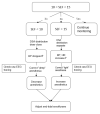EEG-Parameter-Guided Anesthesia for Prevention of Emergence Delirium in Children
- PMID: 36138931
- PMCID: PMC9496666
- DOI: 10.3390/brainsci12091195
EEG-Parameter-Guided Anesthesia for Prevention of Emergence Delirium in Children
Abstract
Background: Emergence delirium (ED) usually occurs in children after surgery with an incidence of 10−80%. Though ED is mostly self-limited, its potential injuries cannot be ignored. Whether electroencephalography (EEG)-parameter-guided anesthesia could reduce the incidence of ED in pediatric surgery has not been fully discussed to date. Methods: Fifty-four boys aged 2−12 years undergoing elective hypospadias surgery under sevoflurane anesthesia were selected. In the EEG-parameter-guided group (E group), sevoflurane was used for anesthesia induction and was maintained by titrating the spectral edge frequency (SEF) to 10−15 and combining the monitoring of density spectral array (DSA) power spectra and raw EEG. While in the control group (C group), anesthesiologists were blinded to the SedLine screen (including SEF, DSA, and raw EEG) and adjusted the intraoperative drug usage according to their experience. Patients with a Pediatric Anesthesia Emergence Delirium (PAED) score > 10 were diagnosed with ED, while patients with a PAED score > 2 were diagnosed with emergence agitation (EA). Results: Finally, a total of 37 patients were included in this trial. The incidence of ED in the E group was lower than in the C group (5.6% vs. 36.8%; p = 0.04), while the incidence of EA was similar in the two groups (61% vs. 78.9%; p = 0.48). Intraoperative parameters including remifentanil dosage and the decrease in mean arterial pressure (MAP) were not different between the two groups (p > 0.05), but the mean end-tidal sevoflurane concentration (EtSevo) was lower in the E group than in the C group (p > 0.05). Moreover, during PACU stay, the extubation time and discharge time of the groups were similar, while the PAED scores within 5 min from extubation and the Face, Legs, Activity, Cry, and Consolability (FLACC) scores within 30 min from extubation were lower in the E group than in the C group. Conclusion: EEG-parameter-guided anesthesia management reduced the incidence of ED in children. Studies with larger sample sizes are needed to obtain more convincing results.
Keywords: DSA; EEG; SEF; anesthetic depth; emergence delirium; pediatric anesthesia.
Conflict of interest statement
The authors declare no conflict of interest.
Figures






References
Grants and funding
LinkOut - more resources
Full Text Sources
Medical

